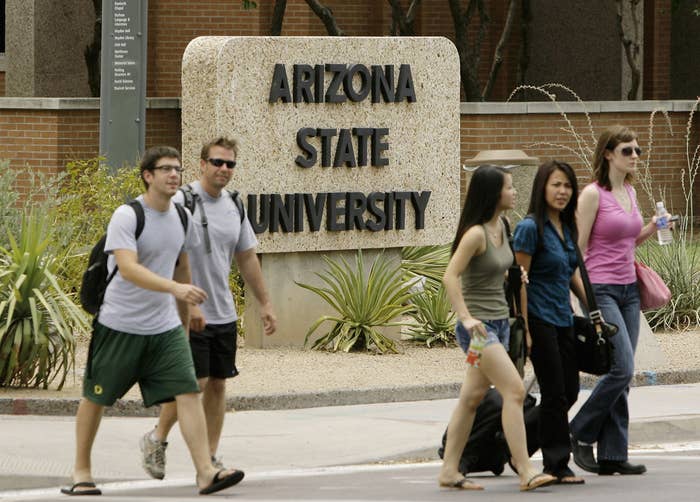
Arizona State University is pioneering a radical rethinking of the freshman year, opening up a year’s worth of online, for-credit courses with no admission requirements, the university announced today. But there’s a catch: The program, which is squarely aimed at students who may struggle to access traditional higher education, also doesn’t allow students to use federal financial aid.
ASU’s “Global Freshman Academy,” a partnership with the nonprofit EdX, is a fundamental departure from how universities have historically operated. It has no application process, no cap on the number of students who can enroll, and, initially, costs nothing but a $45-per-course verification fee. Students who want to use the classes as credits toward a degree will only have to pay after successfully completing the courses, for a total cost of about $6,000 for a full year of credits.
But the university told BuzzFeed News that students could not use federal financial aid to pay for the credits, and that it had no specific plans to make the programs eligible for assistance.
“Frankly, we haven’t thought deeply about what happens with financial aid,” said Anant Agarwal, the CEO of EdX. But ASU and EdX are trumpeting the Freshman Academy as part of a joint mission of increased access, allowing students to bypass many of the barriers they traditionally face in their first years of college.
Thirty percent of college students drop out before they finish their first year, according to estimates, usually leaving saddled with debt and no real progress towards a degree. An untold number, faced with the financial and logistical hurdle of entering school, never even start.
“There’s a significant risk associated” with the way traditional universities are structured, said Agarwal. “You have to pay a large sum of money up front for a course you may not pass, and there are big geographic risks when you move to a new place. We’re going to widen the funnel into college for a lot of learners.”
For poor students, who often face the most challenges in completing a college degree, the $6,000 tab for ASU credit — even if it is only paid after completion — will likely present a significant barrier. Federal financial aid is typically a vital lifeline for poor students hoping to attain degrees.
For a low-income student eligible for a Pell Grant, the Freshman Academy would ultimately cost thousands more than a year at a community college, where the $3,000 tuition is usually fully covered by grants, or even a state university.
“There are a lot of complexities” to offering financial aid to students, said Adrian Sannier, an executive at ASU Online. The decision not to pursue financial aid options, he said, was a “matter of trying to strike a balance between making the program very accessible and lowering the barriers to access,” such as filling out complicated FAFSA forms.
Rachel Fishman, a senior policy analyst at the New America Foundation, said the structure of current federal regulations likely bars students from receiving federal aid for programs like the Freshman Academy. “Existing rules and regulations clearly state that federal financial aid cannot be used to pay for evaluating prior student work,” she wrote in a blog post.
“The hope is that eventually, the government and policymakers will do the right thing. U.S. policymakers are still playing catch-up,” said Agarwal.
The Freshman Academy program is the latest step in ASU’s bid to become a dominant force in online education. It is also part of a push by EdX and others to give real-world value to massively open online courses, or MOOCs, which traditionally offer no course credit.
ASU has put rapid growth, especially in the online world, at the center of its strategy, partly in hopes of competing with for-profit colleges that have traditionally dominated the sphere. The university grabbed headlines last year when it announced a partnership with Starbucks that would allow the company's thousands of baristas nationwide to finish their bachelor's degrees for free at ASU Online. Lured by the prospect of more than doubling its fledgling online enrollment, ASU picked up the bulk of the tab for Starbucks employees by heavily discounting tuition.
The university now has 13,000 full-time online students, and has said it hopes to swell to more than 100,000 by 2020.
The Freshman Academy will likely provide a significant boost to that enrollment. Many students will choose to continue their educations at ASU Online: Though they will have to apply as sophomores, Sannier said that “having successfully completed a freshman year is a very good indicator” of acceptance.
And because two-thirds of EdX users are currently international students from hot markets like China, India, and Brazil, ASU will gain traction as a global brand, a longtime goal of the university.
As a MOOC platform, EdX also has much to gain from the success of Freshman Academy. MOOCs, once heralded as the transformative future of education, have recently flagged, largely because they cannot offer real-world value, like transferable credits, for students who complete the courses. As a result, the vast majority of MOOC students already have a degree, and only a tiny fraction of them — some 6% — actually complete the classes.
Some MOOC platforms, like Sebastian Thrun’s Udacity, have pivoted to offering career-centric training in order to lure students. But EdX is the first to offer open classes that translate directly to university credit.
“Because of the absence of credits, there have been some significant challenges for MOOCs,” said Agarwal. “The question for some students has been, why complete when you’re not getting anything out of it? Now that we can offer credit, it is going to be really appealing to a large number of students.”
